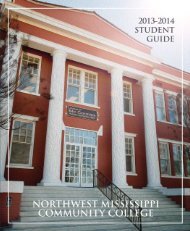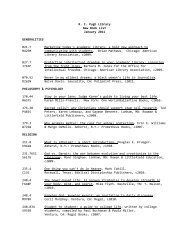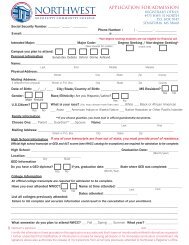Coping with Seven Disruptive Personality Types in the Classroom
Coping with Seven Disruptive Personality Types in the Classroom
Coping with Seven Disruptive Personality Types in the Classroom
Create successful ePaper yourself
Turn your PDF publications into a flip-book with our unique Google optimized e-Paper software.
uses <strong>in</strong> order to frighten and mislead college personnel, as Mr. Cho at Virg<strong>in</strong>ia Tech didwhen he verbalized threats of suicide at <strong>the</strong> po<strong>in</strong>t when he most feared that he would bediscipl<strong>in</strong>ed for stalk<strong>in</strong>g.Ano<strong>the</strong>r concern that sometimes arises <strong>with</strong> antisocial student behavior is an unwill<strong>in</strong>gnessto follow rules or accept <strong>the</strong> Code of Student Conduct. Fortunately, <strong>the</strong>re are legal precedentsto support our ability to <strong>in</strong>voke <strong>the</strong> Code of Student Conduct successfully.The Code of Student Conduct at a college is fairly unassailable. It has been hammered out <strong>in</strong><strong>the</strong> courts. Students have challenged <strong>the</strong>se codes over <strong>the</strong> years, and <strong>the</strong> codes have evolvedout of an extensive legal history. Because <strong>the</strong> matter has already been adjudicated, it issound—much like traffic regulations. A person could challenge those laws aga<strong>in</strong>, but nobodyis go<strong>in</strong>g to sanely argue that we should not have traffic regulations. There have to be laws. Sothat part is not up for debate.If a student, for example, decides to challenge <strong>the</strong> essential centerpiece of <strong>the</strong> regulations at<strong>the</strong> college, which is <strong>the</strong> Code of Student Conduct, and asserts that it is not legitimate and hedoes not have to conform to it, it is not necessary to take <strong>the</strong> student very seriously. This is abit of an exaggeration, but it is a little like say<strong>in</strong>g, “I do not agree <strong>with</strong> <strong>the</strong> law that says thatmurder is a crime. I th<strong>in</strong>k I might just try it out.” It is a form of <strong>in</strong>sanity to th<strong>in</strong>k that way,which would certa<strong>in</strong>ly fall under <strong>the</strong> rubric of sociopathy. You might be will<strong>in</strong>g to have abrief discussion about it for <strong>the</strong> sake of educat<strong>in</strong>g <strong>the</strong> student, but it certa<strong>in</strong>ly is not open todebate.Some sociopaths might very well abate that argument by say<strong>in</strong>g, “Look, <strong>the</strong> rules andregulations of this college do not apply to me. I have my own set.” The response to this isfairly simple and straightforward: “Well, you can have your own set, but you can’t have i<strong>the</strong>re.” That is what such students need to be told.Tell <strong>the</strong> offend<strong>in</strong>g student, “If you do not want to abide by this and do not want to comply,you can keep your belief, but you just can’t be here. If you decide that you’re go<strong>in</strong>g to act <strong>in</strong>such a way as to flout that particular requirement, you just can’t do that here, and here are<strong>the</strong> reasons why. . .” It is not necessary to spend a long period of time try<strong>in</strong>g to arguesomebody out of someth<strong>in</strong>g like that, because it is too bizarre of an assertion <strong>in</strong> <strong>the</strong> firstplace. The response should be simple, straightforward, and direct.14


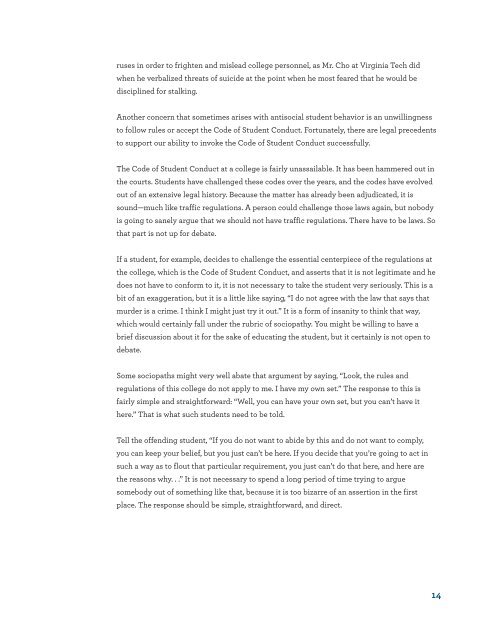

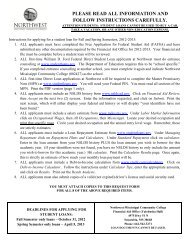




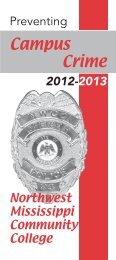

![Pro-Dental Hygiene [Major Code T34] - Northwest Mississippi ...](https://img.yumpu.com/35524032/1/190x149/pro-dental-hygiene-major-code-t34-northwest-mississippi-.jpg?quality=85)

